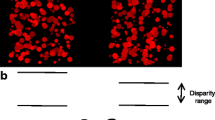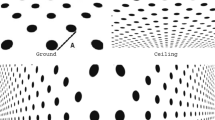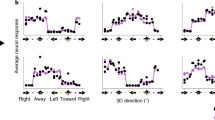Abstract
Binocular differences in orientation and foreshortening are systematically related to surface slant and tilt and could potentially be exploited by biological and machine vision systems. Indeed, human stereopsis may possess a mechanism that specifically makes use of these orientation and spatial frequency disparities, in addition to the usual cue of horizontal disparity. In machine vision algorithms, orientation and spatial frequency disparities are a source of error in finding stereo correspondence because one seeks to find features or areas which are similar in the two views when, in fact, they are systematically different. In other words, it is common to treat as noise what is useful signal.
We have been developing a new stereo algorithm based on the outputs of linear spatial filters at a range of orientations and scales. We present a method in this framework, making use of orientation and spatial frequency disparities, to directly recover local surface slant. An implementation of this method has been tested on curved surfaces and quantitative experiments show that accurate surface orientation can be recovered efficiently. This method does not require the explicit identification of oriented line elements and also provides an explanation of the intriguing perception of surface slant in the presence of orientation or spatial frequency disparities, but in the absence of systematic positional correspondence.
This work has been supported by a grant to DJ from the Natural Sciences and Engineering Research Council of Canada (OGP0105912) and by a National Science Foundation PYI award (IRI-8957274) to JM.
Chapter PDF
Similar content being viewed by others
Keywords
These keywords were added by machine and not by the authors. This process is experimental and the keywords may be updated as the learning algorithm improves.
References
Arnold RD, Binford TO (1980) Geometric constraints on stereo vision. Proc SPIE 238:281–292
Burt P, Julesz B (1980) A disparity gradient limit for binocular function. Science 208:651–657
Jones DG (1991) Computational models of binocular vision. PhD Thesis, Stanford Univ
Jones DG, Malik J (1991) Determining three-dimensional shape from orientation and spatial frequency disparities I — using corresponding line elements. Technical Report UCB-CSD 91-656, University of California, Berkeley
Jones DG, Malik J (1992) A computational framework for determining stereo correspondence from a set of linear spatial filters. Proc ECCV Genova
Julesz B (1960) Binocular depth perception of computer generated patterns. Bell Syst Tech J 39:1125–1162
Julesz B (1971) Foundations of cyclopean perception. University of Chicago Press:Chicago
Kass M (1983) Computing visual correspondence. DARPA IU Workshop 54–60
Kass M (1988) Linear image features in stereopsis. Int J Computer Vision 357–368
Koenderink JJ, van Doorn AJ (1976) Geometry of binocular vision and a model for stereopsis. Biol Cybern 21:29–35
Mori K, Kododi M, Asada H (1973) An iterative prediction and correction method for automatic stereo comparison. Computer Graphics and Image Processing 2:393–401
Quam LH (1984) Hierarchical warp stereo. Proc Image Understanding Workshop.
Rogers BJ, Cagenello RB (1989) Orientation and curvature disparities in the perception of 3-D surfaces. Invest Ophth and Vis Science (suppl) 30:262
Tyler CW, Sutter EE (1979) Depth from spatial frequency difference: an old kind of stereopsis? Vision Research 19:859–865
von der Heydt R, Hänny P, Dursteller MR (1981) The role of orientation disparity in stereoscopic perception and the development of binocular correspondence. in Advances in Physiological Science: 16:461–470 Graystan E, Molnar P (eds) Oxford:Pergammon
Wildes RP (1991) Direct recovery of three-dimensional scene geometry from binocular stereo disparity. IEEE Trans PAMI 3(8):761–774
Witkin AP, Terzopoulos D, Kass M (1987) Signal matching through scale space. Int J Computer Vision 1(2):133–144
Author information
Authors and Affiliations
Editor information
Rights and permissions
Copyright information
© 1992 Springer-Verlag Berlin Heidelberg
About this paper
Cite this paper
Jones, D.G., Malik, J. (1992). Determining three-dimensional shape from orientation and spatial frequency disparities. In: Sandini, G. (eds) Computer Vision — ECCV'92. ECCV 1992. Lecture Notes in Computer Science, vol 588. Springer, Berlin, Heidelberg. https://doi.org/10.1007/3-540-55426-2_71
Download citation
DOI: https://doi.org/10.1007/3-540-55426-2_71
Published:
Publisher Name: Springer, Berlin, Heidelberg
Print ISBN: 978-3-540-55426-4
Online ISBN: 978-3-540-47069-4
eBook Packages: Springer Book Archive




